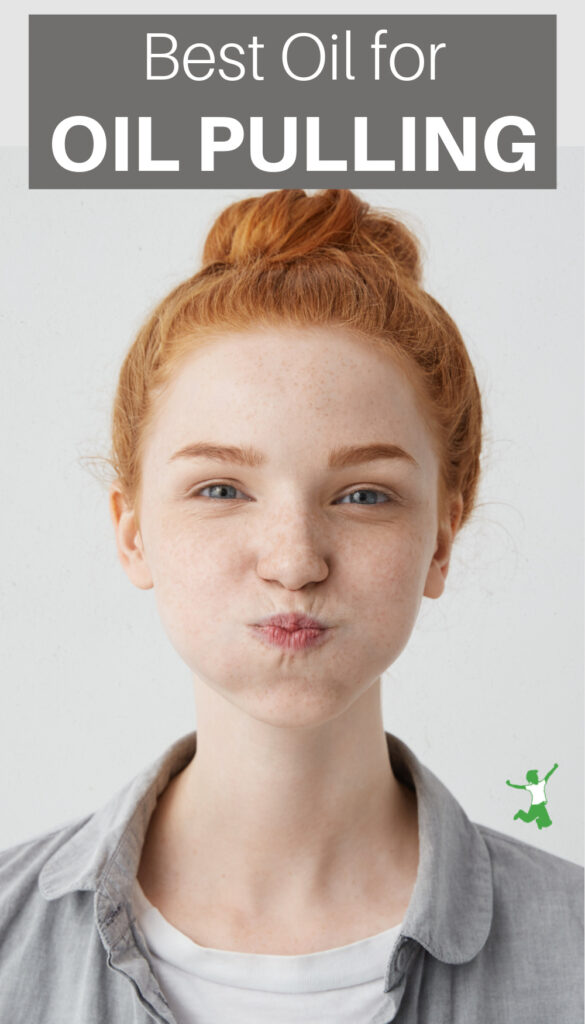The best oils to use for oil pulling for optimal benefits to oral health by eliminating toxins and pathogens from the gateway microbiome.

I first learned about oil pulling two decades ago while studying Ayurvedic cooking.
“Pulling” is an ancient detoxification therapy mentioned in ancient Ayurvedic texts and is recommended as an easy, daily practice.
Over time, “oil gargling” or “swishing” can drastically improve oral health and help resolve many chronic conditions such as periodontal (gum) disease and cavities. (1)
It can also be helpful for acute illness.
For example, oil pulling therapy has been touted as a strep throat remedy and helps resolve persistent sore throat issues.
Oil Pulling Health Benefits
The modern resurgence of this ancestral practice started in 1992 and was initiated by Dr. F. Karach, MD, who used it with great success in his medical practice.
Dr. Karach claimed that oil pulling would resolve a variety of illnesses including hormonal problems, cardiovascular disease, and digestive ailments. (2)
Dr. Bruce Fife, author of Coconut Cures and Oil Pulling Therapy: Detoxifying and Healing the Body Through Oral Cleansing, suggests that oil pulling therapy can effectively be used to clear and heal sinus problems. (3)
In fact, this is one of the first detox symptoms that are experienced is an increased flow/clearing of mucus from the throat and sinuses.
Mucous drainage is one of the body’s best methods of removing toxins.
How Does “Pulling” Work?
The practice of oil pulling is extremely simple.
Simply swish one tablespoon of raw, cold-pressed oil in the mouth for 15-20 minutes.
The swishing process involves gently pushing and pulling the oil around and through the teeth.
Try to oil pull at least once and up to three times per day on an empty stomach.
If you only do it once per day, the best time is first thing in the morning before breakfast or drinking anything. However, if you forget, any time of day before eating will do if necessary.
Dr. Fife advises the following while oil pulling:
While you are pulling, mucous may build in the back of your throat. You may even have to expel the oil and clear the mucous from your throat before reaching a full 20 minutes. That’s okay, take another spoonful of oil and continue until you’ve pulled for a total of 15-20 minutes. (4)
After swishing with the oil for the allotted amount of time, the oil is completely spat out and the teeth, gums, tongue, and palate are gently cleaned by rinsing the mouth with saltwater and brushing as usual.
Feel free to use a bit of sole water for this purpose if you have some on hand.
This next point may seem obvious, but it bears mentioning. It is important to never swallow or otherwise reuse the oil.
I think it is best to spit it out into the toilet rather than the sink because it contains toxins and bacteria and possibly even pus and mucous if an infection is present.
Which Oil is Best?
A variety of oils work very well for oil pulling.
Traditionally, unrefined sesame oil, coconut oil, or butter oil (ghee) were used.
The modern-day practice of this ancient therapy includes extra virgin olive oil or unrefined sunflower oil as alternatives as well.
While any one of these oils is likely effective, is any particular choice better than the others?
According to research performed by Irish scientists from the Athlone Institute of Technology who tested the effects of coconut oil, vegetable oil, and olive oil on dental health, the answer is yes.
Of the three types of oil tested, only coconut oil prevented tooth enamel damage by the pathogen Streptococcus mutans.
This acid-producing bacterium is a common inhabitant of the mouth and a major cause of tooth decay. (5)
This latest finding lends serious credibility to anecdotal claims that oil pulling works best with coconut oil.
Lead researcher Dr. Damien Brady stated that coconut oil could prove to be an attractive alternative to chemicals in maintaining oral health. (6)
He noted that not only does coconut oil work at relatively low concentrations but with the worrisome problem of increasing antibiotic resistance, it is important to consider coconut oil as a potentially novel new way to control microbial infections.
Dr. Fife also recommends making medicated coconut oil to enhance the effects and healing properties of oil pulling. (7)
Refined vs Unrefined
Virgin coconut oil (VCO) is the best choice for oil pulling therapy as it is truly “raw”.
This type of coconut oil is completely unheated with micronutrients and co-factors not present in refined versions. It is ideal for medicinal use.
Remember too, that coconut oil solidifies at 76 °F/24 °C, so if your virgin coconut oil is solid in the pantry, you may need to gently liquefy it in a pan of warm water first.
However, this step is not necessary if you are comfortable letting it melt in your mouth before you start swishing.
If you wish to supercharge the process, you can use ozonated coconut oil, which further enhances the anti-bacterial and anti-plaque benefits of oil pulling.
This therapeutic form of coconut oil is great for holistic dental flossing too and a practice recommended by biological dentists.
Bonus! Virgin coconut oil is an excellent oral antifungal as well.
Is Oil Pulling Right for You?
Oil pulling is probably the cheapest and easiest oral detoxification regimen you could ever try.
It simply involves swishing your mouth with unrefined oil one to three times a day on an empty stomach and then spitting it out.
No dieting, fasting, herbs, or pills are required to get started.
No matter what your age or level of health, oil pulling is harmless and nearly anyone can do it.
Sometimes powerful answers come in a brown paper bag.
Give oil pulling with virgin coconut oil a try!

(1) A review of holistic approaches to oral health
(2) Oil Pulling Therapy by Dr. Karach: Russian Folk Remedy
(3, 4, 7) Oil Pulling Therapy: Detoxifying and Healing the Body Through Oral Cleansing
(5, 6) Coconut oil can combat tooth decay, study suggests








I know raw, unrefined coconut oil is the best, but coconut flavor makes me gag. I buy the refined because there is no flavor. Would there be any benefit to oil pulling with the flavorless variety? Because it would be that or nothing here.
I oil pulled for two weeks with unrefined, organic, pure coconut oil with no results. I have sinus allergies, no help with that either. My kid got sick with the flu, and gave it to me and oil pulling didn’t help with any symptoms. I think it’s a placebo reaction in people. Where is the data and independent studies from someone other than Dr. Fife?? None. Even the internet backs up their data to Dr. Fife. It’s not proven to work independently because it doesn’t. Sorry.
Many times when you start to detox, you get sick because the body is actively trying to process out viruses and bacteria. Two weeks is not long enough to know if oil pulling works for you. As stated above, “Oil pulling, or oil gargling, is an ancient detoxification therapy mentioned in Ayurvedic texts”: there is your data.
Science studies have been done on it and verify everything you read in the post.
Yeah, I wouldn’t use oil pulling when you’re sick and don’t use it regularly. Trying to detox when you’re already sick is not a great idea.
first thing, you do know the properties of oil. Then know the method of oil pulling. That is swishing the oil in the mouth backwards, forwards and sideways, slowly without any vigorous force, for 15 to 20 minutes after which the oil being mixed with saliva become watery and milky white in colour which you should not swallow and spit in toilet and clean the toilet with some toilet cleaner. After spitting the oil, clean your mouth with salt water swishing the water 3 to 4 times and then brush your teeth. Do this daily without gaps. After oil pulling, drink 3 to 4 glasses of water. Wait for 1 hour after drinking water. then start to eat or drink what you do. This is not placebo effect really. To find results, do it at least for 3 or 4 months daily. You will definitely see the result.
I’ve had no filling issues after oil pulling for 8 months. Teeth are brighter and gums feel and look healthier than ever.
Jason Lyons
You wrote this paragraph:
“Virgin coconut oil is the best choice for oil pulling therapy as it is truly “raw” – unheated, unrefined and may contain micronutrients and co-factors not present in expeller pressed coconut oils which are heated as part of the refining process”
This is insinuating that expeller pressed coconut oils are not unrefined, or they cannot be unrefined. Spectrum brand of expeller pressed coconut oil is unrefined. What do you think of that? I live in Panama and you would think we would have tons of coconut here… but the only brands in the store are Spectrum (unrefined expeller pressed) and in a totally over the wall high end organic store I can find the Nutiva brand for about $30 for a jar smaller than a quart!
Also, I read that in ayurvedic medicine you need to use sesame oil, not coconut oil, for oil pulling?
I use coconut oil for oil pulling. I doubt it really detoxes me (I use essential oils in it) but it sure does clean my mouth.
Here in Panama coconut oil is a liquid because the temperature here is so high. If I want it a solid I have to keep it in the fridge. The liquid oil is so much easy to oil pull with.
Expeller pressed has no coconut taste and hence has been subjected to heat. Usually it is steam distillation.
I use tropical traditions. its expeller pressed as I can not afford their gold standard yet. and i know people who eat my baked goods who ask if i put coconut in it. they don’t know I use that oil yet because of dairy issues either. so it does taste coconut.
I used Tropical Traditions expeller pressed for about 10 years and it never tasted coconut. I recently switched to Wilderness Family Naturals as it seems higher quality to me.
It’s amazing!
Following
Is this safe while pregnant and with silver fillings?
It really depends if your fillings are still leaching. If they are several decades old then more likely it won’t be a problem but just to be safe I would still skip it until after you give birth.
I would recommend in the meantime using a 3% solution of Hydrogen Peroxide as a mouth wash and also doing gargles with Baking Soda and Apple Cider Vinegar. This will keep the bacterias at bay while you take care of your child in your belly.
Old mercury amalgam fillings still leach continuously after 50 or more years. Please see my comment above, near the top. Safe amalgam removal is advisable in general along with detox protocols that help this process, but not just prior to becoming pregnant or while pregnant or nursing.
So, I do have to have them removed before I pull? I’ve been pulling with them in. I really want to take them out but not financially possible for me at this time. As Danette mentioned above, if they fall out, I’m worried they will tell me that I need a root canal. Now I’m not sure if I should stop oil pulling or not. Any suggestions?
It is important to use a 3:1 water/peroxide ratio when swishing regularly with hydrogen peroxide. Swishing with undiluted peroxide everyday can damage your enamel. Straight 3% peroxide is great to use for a couple of days if you want to whiten your teeth though!
I second Beth’s concern.
Kellianne Abshier